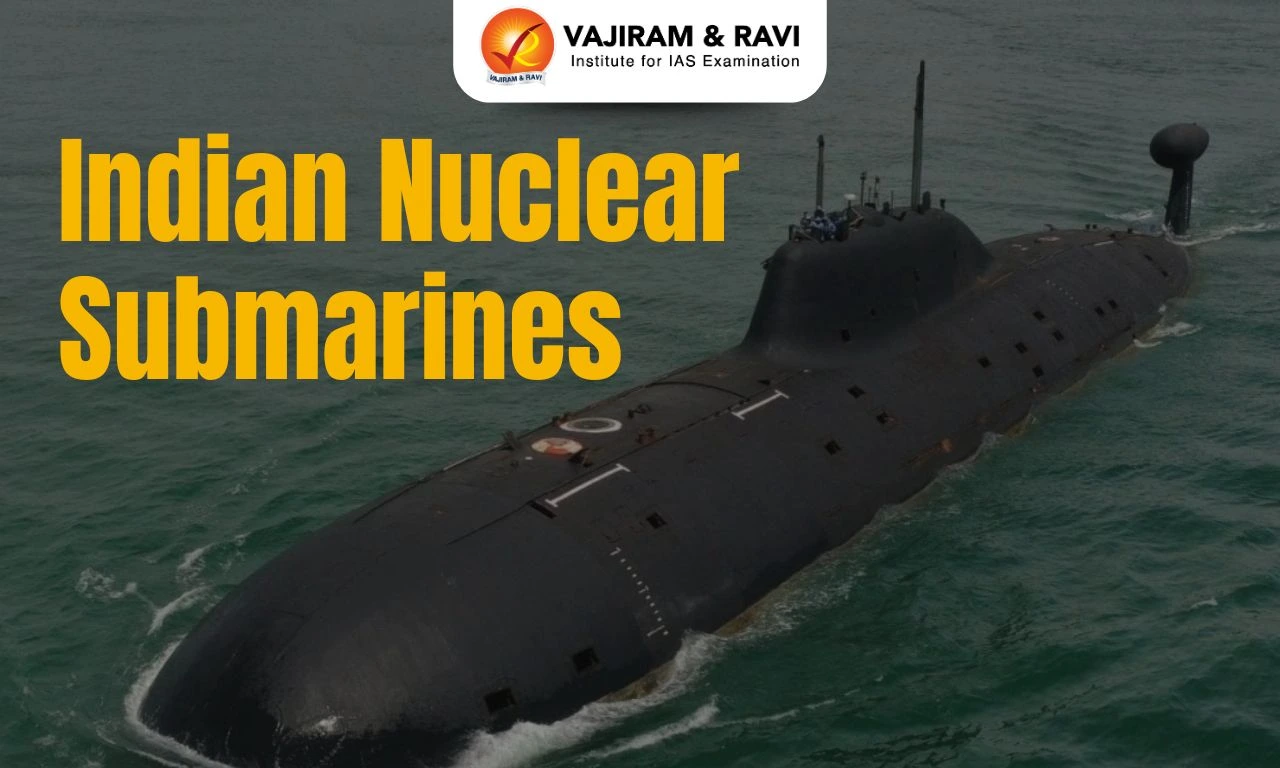A nuclear submarine is a naval vessel that uses a nuclear reactor to power its propulsion. The nuclear submarines may or may not carry nuclear weapons. The history of nuclear submarines goes back to the 1950s when the US first developed it in 1954, named USS Nautilus. Soon it was followed by Russia and subsequently by other naval powers such as France, Britain and China. India too started engaging in nuclear submarine technologies, when it leased a Charlie I class SSN from the USSR in 1987 as well as developing its indigenous SSBN, INS Arihant in 2016. Due to several advancements over conventional submarines, particularly for strategic imperatives, nuclear submarines are very crucial for India’s defence capabilities.
Nuclear Submarines Features
The power source of nuclear submarines is nuclear propulsion fired by the fission of uranium fuel in varied concentrations. This power source makes nuclear submarines more advanced as well as limits their stealth ability in comparison to conventional diesel-powered submarines.
- Technology: Nuclear submarines generate electricity either by powering electric motors connected to the propeller shaft or relying on the reactor heat to produce steam that drives turbines.
- Fuel: Reactors used in submarines typically use highly enriched fuel, generally greater than 20%, so that they can operate longer between refuellings.
- Backup: Generally, nuclear submarines also contain diesel generators as a backup power system, in emergencies.
Nuclear Submarine Advantages
The following are the advantages of nuclear submarines over conventional submarines:
- Endurance: Submarines can carry nuclear fuel for up to 30 years of operation, only limited by the food supply for the crew members and maintenance of the vessel.
- Speed and Power: Nuclear submarines are significantly faster than conventional diesel-electric submarines, achieving speeds above 30 knots.
- Strategic imperatives: They can carry nuclear-tipped ballistic missiles such as SLBMs (Submarine-launched ballistic missiles) serving the strategic interests of a country.
- When a nuclear submarine carries nuclear warheads, it is called SSBN (Ship Submersible Ballistic Nuclear).
- Otherwise, it is called SSN (Ship Submersible Nuclear), which is a nuclear-powered attack submarine.
Nuclear Submarines Disadvantages
The following are the disadvantages of nuclear submarines:
- Large size: The major disadvantage of nuclear submarines is that their large size limits their access to shallow waters, where they can be spotted more easily.
- Expensive: Nuclear submarines are much more expensive to build, operate, and maintain than conventional submarines.
- They require specialised facilities, equipment, and personnel to handle the nuclear reactors and the nuclear waste.
- Easily detectable: Nuclear submarines release heat into the water, which can make them detectable by infrared sensors or thermal imaging.
- They also have to cool down their reactors periodically, which can create a trail of warm water behind them.
- Nuclear submarines generate steam noise from their turbines, which can be heard by sonar or hydrophones. This can compromise their stealth and expose them to enemy attacks.
- Risk of accidents: Nuclear submarines can be harmful if they break, as they have nuclear reactors.
- Many nuclear submarine accidents have happened in the past, sinking the submarines, killing the crew, and spreading radiation in the ocean like the K-19 incident in 1961, the USS Thresher disaster in 1963, and the Kursk explosion in 2000.
Nuclear Submarines in India
India recognised early on that naval supremacy would be crucial to protect its national security interests in the Indian Ocean region. After seeing the threats from nuclear submarines in neighbouring waters, India took determined steps to close this capability gap.
Nuclear-Powered Attack Submarines (SSNs)
India's first exposure to nuclear submarine operations came in the late 1980s on lease from the Soviet Union Navy. The Charlie-I class SSN INS Chakra served in the Indian Navy from 1987 to 1991.
- Significance: Though small and less capable than contemporary nuclear submarines, Chakra allowed the Indian Navy to study nuclear propulsion technology and maintenance practices.
- This experience paved the way for India's own SSN and SSBN programs.
- INS Chakra-II Lease: In 2012, India signed a $1 billion deal to lease a more modern Akula-II class SSN from Russia for 10 years. This 8,140-tonne submarine, INS Chakra-II, joined the Indian fleet in 2012.
- Features: The INS Chakra-II is powered by a 190 MW nuclear reactor, can reach a depth of 600 meters and can travel at speeds of over 30 knots.
- With contemporary sensors, weapons systems, andnuclear-tipped missiles, this submarine significantly enhanced India’s underwater attack capabilities.
- INS Chakra-III: Itis an Akula-class nuclear-powered attack submarine that India has leased from Russia. It is expected to be delivered to the Indian Navy by 2025.
Nuclear Ballistic Missile Submarines (SSBN)
India presently has one nuclear-powered ballistic submarine (SSBN) named INS Arihant (S2). S3 (INS Arighat) is in the developing phase. India’s SSBNs are under the direct control of the PMO and the Strategic Nuclear Command, which oversee their construction, testing and status.
- ATV Project: The Advanced Technology Vessel (ATV) project was launched in the 1980s, and marked India’s place in designing and building nuclear-powered submarines, leading to the creation of the Arihant-class submarines.
- Arihant Class SSBNs (S2): India's first indigenous nuclear ballistic missile submarines (SSBNs) designed and developed under the ATV program.
- Launched in 2009 and commissioned in 2016 features a double-hull with advanced sensors, periscopes, and various weapon systems.
- Power: 1 CLWR-B1 Compact Light-water reactor of 83 MW.
- Speed: 24 knots (submerged) and 15 knots (on the surface).
- Range: Unlimited days
- Armaments: It can carry either 12 K-15 (Sagarika) missiles with a 750 Kms range or 4 K-4 missiles with a 3500 Km range.
- K-4 is a variant of Agni-III, a land-based ballistic missile, and has a range of about 3,500 km.
- K-15 is a variant of Shaurya, another land-based ballistic missile, and has a range of 750 to 1,500 km, depending on the warhead size.
- INS Arighat (S3): It is an upgraded variant of the Arihant-class submarine. It is the second nuclear-powered ballistic missile submarine being built by India under the Advanced Technology Vessel (ATV) project.
- It can accommodate more K4 missiles than S2.
- It is ready and undergoing advanced sea trials, and will be commissioned soon.
- S4: The project for S4, the third Arihant-class SSBN, was launched in 2023.
- S4 is being built to accommodate eight K-4 or twenty-four K-15 SLBMs, more than that by S2 and S3.
- Future SSBN programs: India plans to have four Arihant-class SSBNs and at least two S-5-class SSBNs.
- The S-5-class SSBNs will complement the S-4 and S-4* SSBNs, which carry intermediate-range SLBMs.
- The S-5-class SSBNs, which will have intercontinental range and higher capability, are crucial for India’s nuclear deterrence and triad and should be developed and commissioned as soon as possible.
Nuclear Submarines in India Significance
For India, expanding its submarine fleet with nuclear-powered vessels helps safeguard national security priorities.
- Completing India’s Nuclear Triad: Nuclear-powered ballistic missile submarines (SSBNs) such as INS Arihant provide survivable second strike capability by securing massive retaliation against any nuclear coercion towards India.
- Lower Import Dependency: The development and deployment of indigenous nuclear submarines reduce India's reliance on imported defence equipment.
- Strategic Autonomy: The presence of nuclear-powered submarines in India's naval arsenal serves as a significant deterrent against potential adversaries, contributing to the country's overall strategic deterrence posture.
Nuclear Submarines in India Challenges
India's nuclear submarine program faces several challenges, including budgetary constraints, delays, and institutional ad-hocism.
- Fleet strength: With 4 larger SSBNs like Arihant, India needs 3-4 more nuclear ballistic missile submarines for assured second-strike capability against both adversaries.
- Additionally, 6-8 attack submarines (SSNs) would be required to protect the SSBN fleet.
- Lack of indigenous SSN: India does not have any indigenous SSN design or technology, and relies on leasing Russian SSNs for training and operational purposes.
- While the leased INS Chakra provided much-needed capability boosts, India always intended to develop indigenous nuclear submarines.
- Build period: The INS Arihant project took over 20 years from inception to completion of a deterrent patrol.
- Future platforms will have shorter development timelines due to learning effects.
- Shorter range: To enhance stealth, SSBNs need to operate from distant waters.
- So next-generation SLBMs would require a 6000-8000 km range to effectively deter regional threats.
Last updated on January, 2026
→ Check out the latest UPSC Syllabus 2026 here.
→ Join Vajiram & Ravi’s Interview Guidance Programme for expert help to crack your final UPSC stage.
→ UPSC Mains Result 2025 is now out.
→ UPSC Notification 2026 is scheduled to be released on January 14, 2026.
→ UPSC Calendar 2026 has been released.
→ UPSC Prelims 2026 will be conducted on 24th May, 2026 & UPSC Mains 2026 will be conducted on 21st August 2026.
→ The UPSC Selection Process is of 3 stages-Prelims, Mains and Interview.
→ Prepare effectively with Vajiram & Ravi’s UPSC Prelims Test Series 2026 featuring full-length mock tests, detailed solutions, and performance analysis.
→ Enroll in Vajiram & Ravi’s UPSC Mains Test Series 2026 for structured answer writing practice, expert evaluation, and exam-oriented feedback.
→ Join Vajiram & Ravi’s Best UPSC Mentorship Program for personalized guidance, strategy planning, and one-to-one support from experienced mentors.
→ UPSC Result 2024 is released with latest UPSC Marksheet 2024. Check Now!
→ UPSC Toppers List 2024 is released now. Shakti Dubey is UPSC AIR 1 2024 Topper.
→ Also check Best UPSC Coaching in India

















